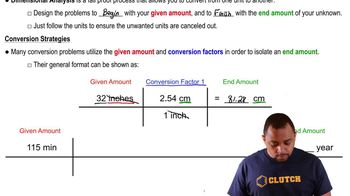The first-order rate constant for the decomposition of N2O5, 2 N2O5(g) → 4 NO2(g) + O2(g), at 70°C is 6.82×10-3 s-1. Suppose we start with 0.0250 mol of N2O5(g) in a volume of 2.0 L. (c) What is the half-life of N2O5 at 70°C?
Ch.14 - Chemical Kinetics
Chapter 14, Problem 47a
Consider the data presented in Exercise 14.19. (a) By using appropriate graphs, determine whether the reaction is first order or second order.
 Verified step by step guidance
Verified step by step guidance1
Start by understanding the order of a reaction, which can be determined by analyzing how the concentration of reactants changes over time. For a first-order reaction, a plot of the natural logarithm of concentration versus time will yield a straight line. For a second-order reaction, a plot of the inverse of concentration versus time will yield a straight line.
Gather the concentration data from Exercise 14.19. You will need the initial concentration and the concentration at various time intervals.
Create a graph plotting the natural logarithm of concentration (ln[Concentration]) on the y-axis against time on the x-axis. If the data points form a straight line, the reaction is first order.
Create another graph plotting the inverse of concentration (1/[Concentration]) on the y-axis against time on the x-axis. If the data points form a straight line, the reaction is second order.
Compare the two graphs. The graph that results in a straight line indicates the order of the reaction. If the ln[Concentration] vs. time graph is linear, the reaction is first order. If the 1/[Concentration] vs. time graph is linear, the reaction is second order.

Verified video answer for a similar problem:
This video solution was recommended by our tutors as helpful for the problem above.
Video duration:
2mWas this helpful?
Key Concepts
Here are the essential concepts you must grasp in order to answer the question correctly.
Reaction Order
Reaction order refers to the power to which the concentration of a reactant is raised in the rate law of a chemical reaction. It indicates how the rate of reaction depends on the concentration of reactants. A first-order reaction has a linear relationship between the concentration of one reactant and the rate, while a second-order reaction involves a squared concentration term, leading to a different graphical representation.
Recommended video:
Guided course

Average Bond Order
Rate Laws
Rate laws express the relationship between the rate of a chemical reaction and the concentration of its reactants. They are determined experimentally and can be used to identify the order of a reaction. For example, a first-order rate law is expressed as rate = k[A], while a second-order rate law can be expressed as rate = k[A]^2 or rate = k[A][B], depending on the number of reactants involved.
Recommended video:
Guided course

Rate Law Fundamentals
Graphical Analysis
Graphical analysis involves plotting data to visually interpret relationships between variables. For reaction order, specific plots can be used: a plot of concentration versus time for first-order reactions yields a straight line when plotted as ln[A] versus time, while a plot of 1/[A] versus time gives a straight line for second-order reactions. Analyzing these graphs helps determine the order of the reaction based on the linearity of the plots.
Recommended video:
Guided course

Dimensional Analysis
Related Practice
Textbook Question
Textbook Question
From the following data for the first-order gas-phase isomerization of CH3NC at 215 C, calculate the firstorder rate constant and half-life for the reaction: Time (s) Pressure CH3nC (torr) 0 502 2000 335 5000 180 8000 95.5 12,000 41.7 15,000 22.4
Textbook Question
Consider the data presented in Exercise 14.19. (c) What is the half-life for the reaction?
Textbook Question
The gas-phase decomposition of NO2, 2 NO2(g) → 2 NO(g) + O2(g), is studied at 383°C, giving the following data:
Time (s) [NO2] (M)
0.0 0.100
5.0 0.017
10.0 0.0090
15.0 0.0062
20.0 0.0047
(a) Is the reaction first order or second order with respect to the concentration of NO2?
(c) Predict the reaction rates at the beginning of the reaction for initial concentrations of 0.200 M, 0.100 M, and 0.050 M NO2.
